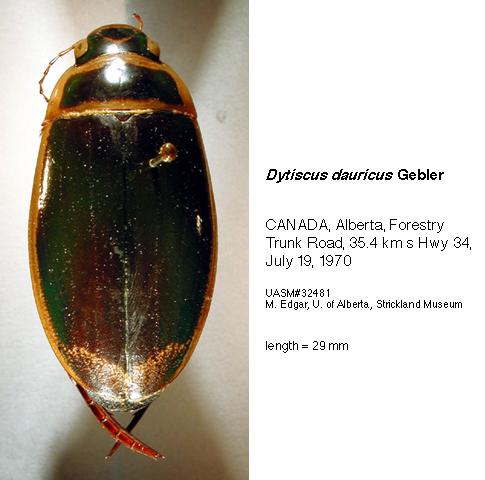Species Details
Dytiscus dauricus
Freshwater Invertebrate Collection Read more about this collection »
SeasonalityAdults emerge from July to September.
IdentificationLarge (29.7 to 40.0mm), broadly elongate (Larson et al. 2000). Black - some with green appearance. Basal antennal segments yellow, darker and reddish terminal segments. All pronotal margins bordered with yellow. Females with reddish or brown-black striae and black ridges. Reddish yellow or reddish ventral surface, except red metacoxa, medially brown-black metasternum, and black anterior and posterior margins of abdominal sterna. Brown-black or black sternal basolateral maculation - progressively smaller to posterior. Yellow or reddish legs.
Scientific Name
Dytiscus dauricus
Seasonality
Adults emerge from July to September.
Identification
Large (29.7 to 40.0mm), broadly elongate (Larson et al. 2000). Black - some with green appearance. Basal antennal segments yellow, darker and reddish terminal segments. All pronotal margins bordered with yellow. …
Large (29.7 to 40.0mm), broadly elongate (Larson et al. 2000). Black - some with green appearance. Basal antennal segments yellow, darker and reddish terminal segments. All pronotal margins bordered with yellow. Females with reddish or brown-black striae and black ridges. Reddish yellow or reddish ventral surface, except red metacoxa, medially brown-black metasternum, and black anterior and posterior margins of abdominal sterna. Brown-black or black sternal basolateral maculation - progressively smaller to posterior. Yellow or reddish legs.
Life History
Overwinter as adults in permanent waters (Larson et al. 2000). Late fall or early spring mating. Univoltine (Aiken and Wilkinson 1985). Strong swimmers, hind legs move together while swimming. Adults attracted to lights.
Conservation
No special status (IUCN 2002).
Diet Info
Predatory - active swimmers (Larson et al. 2000). Invertebrate and fish larvae prey. Records of larval cannibalism and predation on salamanders and snakes in Arizona (Holomuzki 1985, 1986).
Range
Holarctic (Larson et al. 2000). This species is recorded from most of Alberta. Wide distribution through Boreal zones and Western Cordillera. Aleutian Islands, Alaska to Newfoundland, as far south as California and…
Holarctic (Larson et al. 2000). This species is recorded from most of Alberta. Wide distribution through Boreal zones and Western Cordillera. Aleutian Islands, Alaska to Newfoundland, as far south as California and Arizona. Found at sea level in northern parts of range to increasingly higher elevations in southern part of range. One record from northwestern China; records from Soviet Union, east of Lake Baikal.
References
Title
2002 IUCN Red List of Threatened Species.
Publication Date
2002
Series Title
Ecology
Author
Aiken, R. B. and C. W. Wilkinson
Title
Bionomics of Dytiscus alaskanus J. Balfour-Browne (Coleoptera: Dytiscidae) in a Central Alberta Lake.
Publication Date
1985
Series Title
Canadian Journal of Zoology
Volume
63
Pages
1316-1323
Author
Larson, D. J.; Alaire, Y. and R. E. Roughley
Title
Predaceous Diving Beetles (Coleoptera: Dytiscidae) of the Nearctic Region, with emphasis on the fauna of Canada and Alaska.
Publication Date
2000
Pages
982
Specimen Information
There is 1 specimen of this Species.
IN4777 - Dytiscus dauricus
Freshwater Invertebrate Collection
Place CollectedCanada: Alberta, Wood Buffalo National Park
Collected ByClassen, M.
Date Collected2005-05-22
